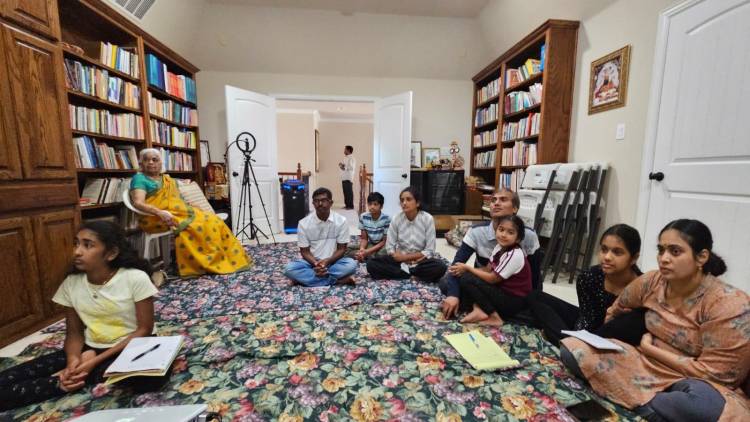[GHHF] Amazing Hindu Temples that defy science, and logic; Sanatana Dharma classes started in Frisco Texas
 Global Hindu Heritage Foundations and Dharma Jagruti Foundation started for youth and adults to teach about the richness and grandeur of Sanatan Dharma to equip them with enough knowledge to be proud of their culture. Thes classes started on May 25th and will continue for the next couple of months. Over the last eight weeks we talked about Santana Dharma, the architectural wonders of Hindu Temples, the traditions and customs practiced in Hindu Temples, comparing Hindu Temples to the human body, the significance of rituals practiced in Hindu Temples, the significance of the Murti worship, the difference between monotheism and polytheism, the dangers of monotheism and the importance of spirituality.
Global Hindu Heritage Foundations and Dharma Jagruti Foundation started for youth and adults to teach about the richness and grandeur of Sanatan Dharma to equip them with enough knowledge to be proud of their culture. Thes classes started on May 25th and will continue for the next couple of months. Over the last eight weeks we talked about Santana Dharma, the architectural wonders of Hindu Temples, the traditions and customs practiced in Hindu Temples, comparing Hindu Temples to the human body, the significance of rituals practiced in Hindu Temples, the significance of the Murti worship, the difference between monotheism and polytheism, the dangers of monotheism and the importance of spirituality.
Dr. Prakasarao Velagapudi started his religious and spiritual journey nearly four decades ago and continued to champion the cause of Sanatan Dharma for peace, tolerance, patience, science and logic. This week we talked About the mysterious Temples that defy science and logic. Many of these Temples were built thousands of years back with no modern technology, tools and materials. The mystery of these Temples will give challenge your mind, intelligence and reason. They will give you goosebumps. And make you dumb. They will shock you with their mysteries and make you wonder. The more you know about these miraculous Temple more you will be excited and thrilled. Here are few Hindu Temples.
1) Veerabhadra Swamy Temple in Lepakshi in Andhra Pradesh. There are about 70 pillars. One of the pillars will be hanging without touching the floor. One can swipe a piece of cloth or paper mid air that separated ground and pillar. As a matter of fact, a curious British Engineer tried to figure out the secret of its support, consequently dislodging it a bit. Some believe that the entire complex stands on the pillar.
2) Kailash Temple in Ellora Caves in Maharashtra. The temple is built on an amazingly carved mountain with intricate details. Kailasa Temple is the largest rock-cut Hindu temple in 16th-century Ellora Caves. This temple will give you a reason to enhance your knowledge of Indian mythology like never before. The structure of Kailasa Temple is monolith which means this cave temple is built on a single rock. The carvers started at the very top of the cliff and worked their way downwards, cutting away massive amounts of rock around the planned temple structure. This technique, called vertical excavation, is rarely seen in other ancient structures of this scale. This technique, called vertical excavation, is rarely seen in other ancient structures of this scale.
3) Sri Suryanarayana Swamy temple at Arasavalli, Andhra Pradesh: In this Temple, the sun's rays fall on the feet of the deity twice a year, during the Uttarayanam (March 9-11) and Dakshinayanam (October 1-3) periods. This phenomenon occurs because of the temple's unique architectural design, which allows the sun's rays to directly illuminate the idol's feet during these specific times. The event is a significant draw for devotees who visit the temple to witness this rare and auspicious sight, according to the Times of India.
4) Balaji Temple in Karnataka: The miracle: One of the most awe-worthy things at the temple is the fact that when hot water Abhishekam is performed, the head remains hot, but the feet of the idol are cold. That is, when the priest or the devotee pour hot, boiling water over the idol, once the water reaches the deity’s feet it is cold as ice. But it is also noteworthy that while the feet and the water near the feet turn cold, the head of the idol is still hot to touch.
Adding to the mystery of the deity and the idol is the story that when water is poured directly from the navel of the idol, it remains hot when touched, and it is only when the water is poured over his head, does it turn cold when reaching his feet.
5) Puri Jagannath Temple, Orissa. The temple hosts the biggest mega kitchen in the world. The most mysterious fact about the temple is that the food in this temple is always cooked by stacking pots one over the another and the topmost pot always gets cooked first. The flag always flaps in a direction opposite to the direction in which the wind is blowing.
Gaze from any place in Puri, and you will always find the Sudarshan Charka (charka at the top of the temple) always facing you. In the temple kitchen, seven pots are kept on top of each other and cooked on firewood. In this process, the contents of the top pot get cooked first, lastly, the bottommost one! On entering from Singhadwara, as one takes the first step inside the Temple, you can’t hear any sound produced by the ocean. But when you cross the same step outside the Temple, you can hear it.
6) Umamheswara Temple, Yaganti near Kurnool, Andhra Pradesh. Nandi Statue grows in size. The devotees believe that the Nandi idol in front of Umamaheswara Temple in Yaganti in Kurnool is continuously increasing its size. The locals say that the idol was initially much smaller than its present size. They say that certain experimentation was carried out on this idol, and it was said that the type of rock out of which the idol is carved has a growing or enlarging nature associated with it. Archaeological Survey of India has confirmed that the idol increases by 1 inch in every 20 years. Experiment suggests that the rock used to make the idol exhibits a growing nature.
It is said that people used to do Pradakshinas (rounds) around it in the past. The temple staff has already removed one pillar as the size of the Nandi has increased.
7) Panakala Narasimha Swamy, Mangalagiri, Andhra Pradesh. The Narasimha here is offered Panakala (Jaggery water) which is poured directly into the mouth of the deity by a conch. One can hear a gargling sound as the jaggery water is offered which becomes high pitched, then lowers. The temple’s unique offering of “panakam,” a sweet drink made with jaggery water, cardamom, and spices, holds deep symbolic significance. It is believed to represent the quenching of Lord Narasimha’s thirst and anger, symbolizing the pacification of negative forces and the restoration of balance. Devotees offer panakam with devotion, seeking the Lord’s protection from evil and the bestowal of inner peace.
8) Kamakhya Devi Temple: Guwahati, Assam. The temple has no sculptures to worship, and the Goddess in every monsoon menstruates. Perched on Nilachal Hill in Guwahati, this Shakti Peetha isn’t your typical temple—no idol here, just a yoni-shaped stone that’s said to bleed. Every June, during the Ambubachi Mela, the temple shuts for three days as the goddess “menstruates,” turning an underground spring red. Locals swear it’s divine; skeptics hunt for answers. Tantric vibes and black magic rumors swirl—legend ties it to Sati’s womb falling here after Shiva’s cosmic meltdown. It’s raw, sacred, and downright eerie, drawing crowds who celebrate womanhood in a way that’s rare even in India.
9) The Musical Pillars of the Vittala Temple in Hampi, Karataka. One of the notable features of the Vittala Temple is the musical pillars. The large Ranga Mandapa is well known for its 56 musical pillars. These pillars are also known as SaReGaMa pillars, which are attributed to the musical notes emerging out of them. The pillars produce musical tones when struck with a thumb. It sounds like bells ringing. Each pillar provides support to the ceiling of the mandapa, and the main pillars are designed in the manner of musical instruments. Every main pillar is wrapped by 7 minor pillars and these minor pillars emit different musical notes.
In summary, in addition to these mysterious Temples, we talked about Brihadeswara Temple in Tamil Nadu, Chaya Someswara Temple in Telangana, Subramanya Swamy Temple in Kerla, Angkor Wat Temple in Cambodia, and others.
Donations are welcome:
• Zelle: ghhfusaorg@gmail.com
• PayPal: savetemples.org
• Check: Payable to GHHF, 14726 Harmony Lane, Frisco, TX 75035
• Rupees: Call 601-918-7111 or +91 83096 43979
All donations are tax-deductible.


















 Urgent support needed for Bangladesh Hindus
Urgent support needed for Bangladesh Hindus 







